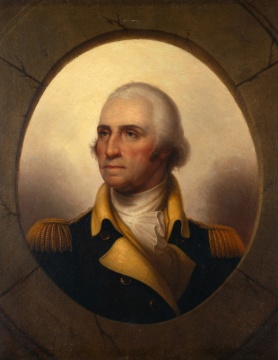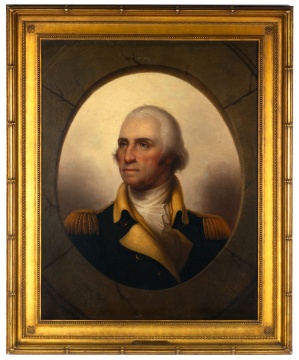Rembrandt Peale (1778-1860) George Washington


Hammer Price w/ BP
$492,000
| Lot #: 244 Rembrandt Peale (1778-1860) George Washington |
|
Circa 1846. Oil on canvas. Signed 'Rembrandt Peale' (lower left). Documents: Original invoice and correspondence. Appraisal by Wildenstein & Co. Inc., New York dated Nov. 15th, 1928. Note: When he was eighteen, Rembrandt Peale painted a portrait of Washington from life in the presence of his father, Charles Willson Peale. During the remainder of his career, Rembrandt demonstrated a near obsession with Washington and replicated this famous portrait seventy-nine times. The stone oval derives from the seventeenth-century European fashion for tromp l'oeil stone casements, a format Peale may have observed during periods of study in Europe. |
| 36 x 30 in. |
|
Provenance The Artist. Giles F. Ward (1812-1885), purchased Feb. 22nd, 1845. Lucy Bell Ward (1847-1926). Mrs. Sully, whose husband was a grandson of Thomas Sully. M. Knoedler & Company, New York. Colonel Charles Clifton, Pierce-Arrow Motor Car Co., purchased April 12th, 1926. Mrs. Alice (Clifton) Strachan, Buffalo, New York. Thence by descent. |
|
Auction Date Sep 21, 2024 |
Details:
Born on Washington’s birthday during the American Revolution, Rembrandt Peale (1778-1860) felt destined to create the ultimate portrait of George Washington which he believed would be the “standard likeness” of the nation’s first president. In 1823, he drew upon his previous endeavors, as well as those by John Trumbull, Gilbert Stuart, his father, and Jean-Antoine Houdon.
Rembrandt depicts Washington with a strong brow, Roman nose and pronounced jaw, characteristics that recall Houdon’s version. Rembrandt created a composite image of the American hero; idealized to communicate a figure that transcends the confines of mortality. He is framed by an illusionistic trompe l’oeil stone masonry window, reminiscent of Roman funerary sculpture; another influence of neoclassicism and a nod to the Roman Republic from which the ideals of the country were rooted. Rembrandt paints Washington against a background of clouds. By not placing him in a specific place and time, he creates an ethereal image of the man and elevates him to an almost godly status.
Washington sat for Rembrandt Peale three times, each for three hours in the autumn of 1795. The experience was documented by both men in their letters. While the President expresses a concern that the burdens of his responsibilities for the young Republic would be revealed in the likeness Peale was rendering, the artist expresses the fact that this was an opportunity of a lifetime for a young portrait painter.
Rembrandt Peale recalled, “It was in the autumn of 1795 that, at my father’s request, Washington consented to sit to me, and the hour he appointed was seven o’clock in the morning. I was up before daylight putting everything in the best condition for the sitting with which I was to be honored, but before the hour arrived became so agitated that I could scarcely mix my colors, and was concerned that my anxiety would overpower me and that I should fail in my purpose unless my father would agree to take a canvas alongside me and thus give me an assurance that the sittings would not be unprofitable, by affording a double chance for a likeness...”
Shipping Information:
Unlike many auction companies, Cottone Auctions offers a full-service shipping department. We’re equipped to pack and safely ship just about any item to just about any location around the globe.
Learn more >


